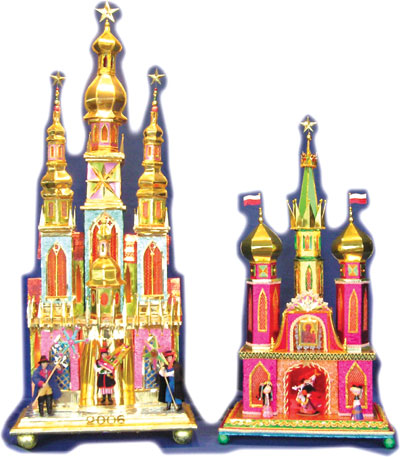A New Twist to Old Traditions

Observing an age-old custom from the Middle Ages, several area artisans will unveil their latest creations during the sixth annual Pittsburgh Szopka Exhibition and Holiday Reception, sponsored by the University of Pittsburgh Nationality Rooms Program and the Polish Classroom Committee. The free public event will be held in the Cloister of the Frick Fine Arts Building from 1 to 4 p.m. Dec. 14.
Originally built as Medieval puppet theaters in the churches of Cracow, Poland, the szopka (“shop-kah”)—or Cracow crèche—is now a revered holiday tradition in the Cracow region. The szopka combines everyday materials, such as wood, cardboard, foiled paper, and ribbon to make whimsically ornate architectural structures, ranging in size from a few inches to several feet. Unlike the traditional Western nativity scene, the szopka portrays historical buildings from Cracow.
Cracow Crèche Workshop, an educational forum founded by David Motak, has helped bring the szopka folk art to the United States. Motak is a Pittsburgh-area educator and artist who has been offering formalized szopka-building workshops for six years.
The Dec. 14 exhibition will include a Polish holiday reception, ethnic food and music, and the display of more than 20 szopki (“shop-key”) made by Pittsburgh-area artisans at annual szopka classes, as well as by parents and children who participated in two Cracow Crèche Workshop sessions at the Pittsburgh Children’s Museum in November.
An added attraction at this year’s event will be a preview of The Poles in Pittsburgh: Yesterday, Today and Tomorrow, a multipanel exhibition on the history of Poles in Western Pennsylvania. The display was recently developed by Motak for the Polish Cultural Council to celebrate the achievements and contributions of Poles in Western Pennsylvania. The display comprises five large professionally produced display panels incorporating vintage illustrations, graphics, and text in a visual arts presentation. Poles in Pittsburgh takes the viewer on a journey from the establishment of the Polish State in 966, to the role that Poles played as settlers in the Jamestown Colony in 1608, through their contributions to Pittsburgh’s industry, social life, and culture. The display also presents Polish-American life and traditions, including the community’s culinary contributions, holiday observances, and religious life. The exhibition will travel throughout Western Pennsylvania in 2009.
Eva Tumiel-Kozak, executive director of the Polish Cultural Council, said the combination of a history exhibition and holiday szopki will present a diverse picture of Polish traditions and history.
“The annual Pittsburgh szopka exhibition attracts many people from the ethnic community as well as from the general public. Many exhibition attendees are primarily interested in the arts, so this is a natural venue for us to reach a wider audience and showcase the contributions Poles have made to our region in a very visual and dynamic way.”
Motak added Cracow’s annual public exhibition of szopki represents the traditional launching of the holiday season. “To many ethnic Pittsburghers, our annual exhibition now serves a similar function.”
Additional information is available by contacting Motak, 412-835-0539 or contact@cracowcrafts.com
Other Stories From This Issue
On the Freedom Road

Follow a group of Pitt students on the Returning to the Roots of Civil Rights bus tour, a nine-day, 2,300-mile journey crisscrossing five states.
Day 1: The Awakening
Day 2: Deep Impressions
Day 3: Music, Montgomery, and More
Day 4: Looking Back, Looking Forward
Day 5: Learning to Remember
Day 6: The Mountaintop
Day 7: Slavery and Beyond
Day 8: Lessons to Bring Home
Day 9: Final Lessons

